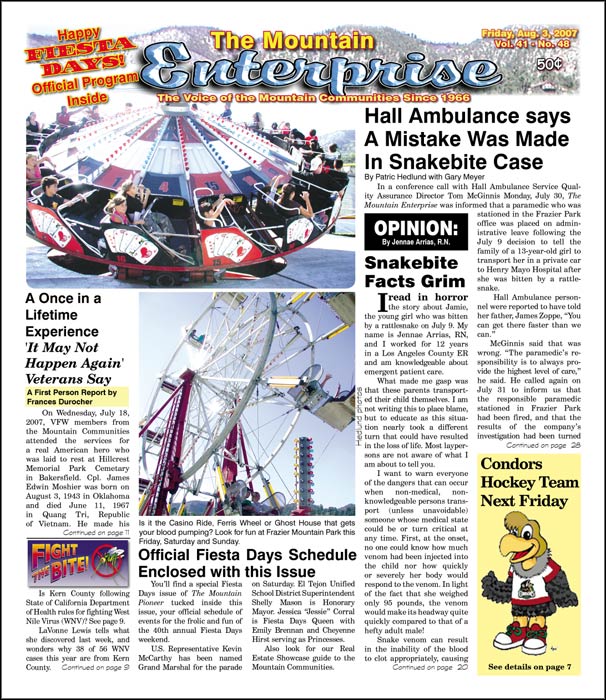By Jennae Arrias, R.N.
I read in horror the story about Jamie, the young girl who was bitten by a rattlesnake on July 9. My name is Jennae Arrias, RN, and I worked for 12 years in a Los Angeles County ER and am knowledgeable about emergent patient care.
What made me gasp was that these parents transported their child themselves. I am not writing this to place blame, but to educate as this situation nearly took a different turn that could have resulted in the loss of life. Most laypersons are not aware of what I am about to tell you.
I want to warn everyone of the dangers that can occur when non-medical, non-knowledgeable persons transport (unless unavoidable) someone whose medical state could be or turn critical at any time. First, at the onset, no one could know how much venom had been injected into the child nor how quickly or severely her body would respond to the venom. In light of the fact that she weighed only 95 pounds, the venom would make its headway quite quickly compared to that of a hefty adult male!
Snake venom can result in the inability of the blood to clot appropriately, causing little clots and microscopic diffuse bleeding throughout the body, red blood cells break open, muscle tissue breaks down, circulating blood volume can fall (measured by blood pressure) which contributes to heart and renal failure, potassium (plays a vital role in muscle contraction) leaks out of muscles causing cardiac malfunction, respiratory muscles can become paralyzed, and body tissues swell.
Even though her blood pressure was adequate when first checked, this could change within minutes, as the venom coursing through her system would increasingly wreak havoc. Medical personnel are taught that early on a child’s blood pressure holds up quite well. This is because children have strong compensatory mechanisms that sustain blood pressure. But as the compensatory mechanisms fail, the blood pressure can quickly drop…an especially ominous sign in children.
Also, one of the golden rules of medicine is that as "professionals" we are discouraged from providing care to a relative. The reason is because your emotions often interfere with the ability to make rational decisions. I have experienced this and it is absolutely true. This also applies to parents, or to any close relationship, when one is experiencing a life-threatening event involving a loved one. Yet, these beset upon parents cared for their sick child for nearly an hour before reaching the ER.
I don’t understand how the parents could have gotten there faster as was stated in the article. From my experience, ambulances can travel under what is called a "Code 3." This means they can travel a certain amount over the speed limit…but, if nothing else, they have the advantage of having a siren and red lights to alert other road travelers to an emergency in progress and as a method of clearing the roadway. This would allow the parents to focus on their child and not be burdened with having to make traffic decisions; providing a safer transport of patient and family.
Now here we have parents who are "scared," stressed to the max, traveling on a busy stretch of highway with their traumatized daughter whose status is worsening, and other children in the car…any number of things could have gone wrong to further place this family at risk: Being caught in traffic, getting a flat tire, being in an accident, or being pulled over by the California Highway Patrol for speeding as speeding often occurs when one is under a sense of urgency. Some may feel that being pulled over may be of benefit, though trained in CPR, CHP officers are not equipped to care for emergent situations such as this..
From the newspaper account, this patient was decompensating during transport. The parents could do nothing because they had neither the knowledge nor the required medical supplies and medicines available to them. Ambulances, whether manned by EMTs or paramedics, have oxygen and ambu-bags on board that can make the difference between life and death. Further, intubation kits (an artificial airway that keeps the throat open) and IV lines can be started with fluids and medications administered, which provide some degree of control for anaphylactic shock (massive organ system shut down). And ambulance personnel usually have some method of contacting an MICN (specialized nurse for these situations) or an ER doctor to obtain orders for medication and/or fluid administration as needed.
This child and her family are indeed blessed. With her airway closing by the ongoing swelling of her throat, the outcome could have been very different if precious minutes had been lost along the highway with nothing available to them to stay off a pending disaster.
I urge all mountain community residents and visitors to always sway on the side of caution. Opt for the ambulance ride when experiencing chest pain; respiratory distress (inability to speak full sentences, wheezing, gurgling up fluid from lungs, altered consciousness, bluish around mouth, face or extremities); loss of consciousness; significant bleeding or dehydration, prolonged vomiting and/or diarrhea (causes severe dehydration), or other such symptoms that are life threatening or could become life threatening…including snake bites. This is especially true of the very young and the very old.
And, why don’t we have anti-venin in this snake-ridden territory? We have it for dogs, but not people?
As you’ll read in the story "Hall Ambulance says a Mistake Was Made in Snakebite Case," Hall Ambulance Service has terminated the employment of the paramedic who made the decision not to provide care.
See "Snakebite Response Touches Family" to read a letter to the editor from Jamie’s mother Brenda Zoppe relating the overwhelming response her family has received from the Mountain Communities.
This is part of the August 03, 2007 online edition of The Mountain Enterprise.
Have an opinion on this matter? We'd like to hear from you.


